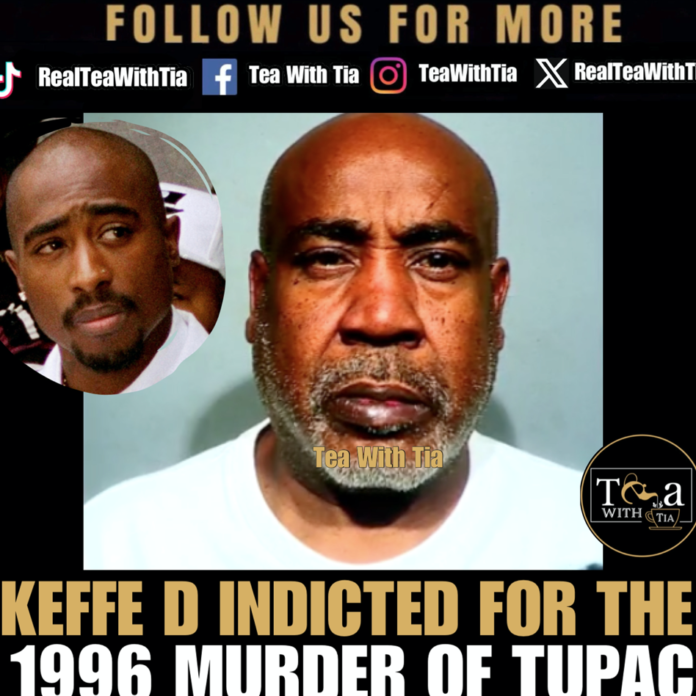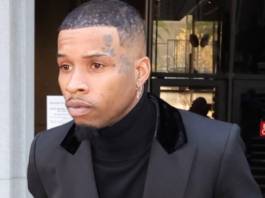One of the last living witnesses to the fatal drive-by shooting of rapper Tupac Shakur in Las Vegas was charged with murder Friday in the 1996 killing, a long-awaited breakthrough in a case that has frustrated investigators and fascinated the public.
Duane “Keefe D” Davis has long been known to investigators and has himself admitted in interviews and in his 2019 tell-all memoir, “Compton Street Legend,” that he was in the Cadillac from which the gunfire erupted during the September 1996 drive-by shooting. Shakur was 25 when he was killed.
Who Killed Tupac?
Keefe D avoided directly naming the person who opened fire in recent interviews. But in a taped confession released by a former Los Angeles Police Department detective who investigated Tupac’s murder, Keefe D told the police that it had been Orlando Anderson, his nephew, who was known as Baby Lane.

Keefe D, says a gang dispute is what escalated after Tupac and his associates beat up his nephew, following the boxing match at the MGM Grand Hotel (see video on Youtube below)
“Them jumping on my nephew gave us the ultimate green light to do something,” Davis said in the memoir, “Compton Street Legend.”“Tupac chose the wrong game to play.”
On the night of the shooting, Tupac had been traveling in the passenger seat of a BMW driven by Marion Knight, the rap mogul known as Suge, toward a postfight after-party at Club 662, a new venue backed by their record label, Death Row.

Keefe D, a self-described member of the Crips, wrote in his memoir that he, Orlando, and others had armed themselves and waited in the nightclub parking lot, hoping to confront Tupac and Suge, who were associated with the Bloods, about the earlier violence. Keefe D wrote.
In an interview with VladTv, he says that it looked like Tupac was reaching for a gun moments before the shots were fired at Suge Knight and Tupac.
In his memoir, Keefe D said that after the shooting, the men abandoned the car and walked back to the hotel, picking the vehicle up the next day and taking it back to California. It sat for a couple of days and was taken to be cleaned and painted before it was returned to the rental agency, Keefe D said. By that point it was “too late for any forensics to be accurate and reliable,” he noted.

Keefe D said Tupac’s crew had committed “the ultimate disrespect when they kicked and beat down my nephew” — an attack thought to be retribution for an earlier robbery of one of Tupac’s friends. In his memoir, Keefe D described the “strict code” of the streets that its participants “live, kill and die by.”
“Tupac’s and Biggie’s deaths were direct results of that code violation and the explosive consequences when the powerful worlds of the streets, entertainment, and crooked-ass law enforcement collide,” he wrote.
The Aftermath Of Tupac’s Death

Just five years into his career as a major-label solo artist when he was killed, Tupac had already become one of the most popular rap artists of the 1990s with albums such as “Me Against the World,” on which he rapped about a life imperiled by violence, and “All Eyez on Me,” one of the genre’s first double albums.
Immediately after Tupac’s death, there was a bunch of activity in the investigation. More than 20 people were arrested in connection with shootings that the police said were suspected to be gang-related attacks stemming from the rapper’s killing.
But as the years went on without any charges, Tupac’s death — combined with that of his rival, the Notorious B.I.G., six months later — fueled conspiracy theories and accusations that the police had not worked hard enough to bring the young Black artist’s killers to justice. The Las Vegas police have cited a lack of cooperation from people close to Tupac as a reason for the stalled investigation.
The killings became the subjects of books, podcasts, TV series, and films, further elevating Tupac to a mythic role in hip-hop.
Less than six months after Tupac’s murder, Brooklyn rapper Biggie Smalls — was killed in a drive-by shooting in Los Angeles.
The investigation into the death of Biggie was revived by the Los Angeles Police Department in the mid-2000s, ultimately leading to a re-examination of Tupac’s killing. Greg Kading, one of the detectives who had been involved in the inquiry, later wrote a book that detailed how investigators convinced Keefe D to cooperate with them by offering a proffer agreement, meaning that he could not be charged with a crime based on any incriminating statements he might make in those interviews.
The Indictment
Keefe D added that he had been considered a “prime suspect” in both murders and called writing about the events for his book “therapeutic.” No one has ever been charged for Biggie’s March 9, 1997, murder. It’s long been believed the killings were connected to a rivalry between the two rappers.

Kading, who is not associated with the current investigation, said in an interview with TMZ around the time of the search warrant that Keefe D had been protected from being prosecuted for his conversations with the police more than a decade ago, but that he views Keefe D’s more recent statements about his role in the killing as fair game for prosecutors.
The Las Vegas Metro Police has never stopped working on this case. Police served a search warrant on Keefe D at his home near Las Vegas on July 17, looking for laptops and other electronic devices in connection with the decadeslong investigation.
“I ended up pulling Tupac out of the car,” retired LVMPD Lt. Chris Carroll told NBC affiliate KSNV over the summer, just after the search warrant was served on Keefe D. “I spoke to him. He was still alive. He was still breathing.”
Carroll, a sergeant at the time, said he vividly remembers his brief interaction with Tupac.
I was asking him who did it, who shot him, what happened?” said Carroll. “And that’s when he responded to me with the now infamous words ‘F-U’.
During the interview with Vlad TV, Keefe D was asked whether he was concerned that his disclosures could lead to a prosecution. Keefe D, who described himself in his memoir as having run a “multi-million-dollar nationwide drug empire” and was incarcerated for roughly 15 years, partly on federal drug charges, said he wasn’t scared of prison.
“They want to put me in jail for life?” he said. “That’s just something I got to do.”
A Nevada grand jury indicted Keefe D in the killing, prosecutors announced in court Friday. Chief Deputy District Attorney Marc DiGiacomo said a grand jury had been seated in the case for several months. DiGiacomo described Keefe D as the “on-ground, on-site commander” who “ordered the death” of Tupac Shakur.

Keefe D is the only one facing charges due to him being the last living suspect. This is a developing story.
For more stories, subscribe to join the Tea Party. If you have a story, tip, or tea please text/call 919.885.4306 or email [email protected]


![TORY LANEZ LEGAL TEAM FILES OPENING BRIEF FOR HIS APPEAL [LEGAL DOCUMENTS ATTACHED]](https://teawithtia.org/wp-content/uploads/2024/02/Screen-Shot-2024-02-28-at-12.51.29-AM-265x198.png)
![DRAKE TRENDS ON TWITTER AFTER AN ALLEGED NUDE VIDEO LEAKS [EXPLICIT]](https://teawithtia.org/wp-content/uploads/2024/02/IMG_3659-265x198.jpeg)
